
Exposé Online
What's old
Exposé print issues (1993-2011)
- 1 (October 1993)
- 2 (February 1994)
- 3 (May 1994)
- 4 (August 1994)
- 5 (October 1994)
- 6 (March 1995)
- 7 (July 1995)
- 8 (November 1995)
- 9 (March 1996)
- 10 (August 1996)
- 11 (February 1997)
- 12 (May 1997)
- 13 (October 1997)
- 14 (February 1998)
- 15 (July 1998)
- 16 (January 1999)
- 17 (April 1999)
- 18 (November 1999)
- 19 (May 2000)
- 20 (October 2000)
- 21 (March 2001)
- 22 (July 2001)
- 23 (December 2001)
- 24 (April 2002)
- 25 (September 2002)
- 26 (February 2003)
- 27 (August 2003)
- 28 (December 2003)
- 29 (April 2004)
- 30 (September 2004)
- 31 (March 2005)
- 32 (September 2005)
- 33 (May 2006)
- 34 (March 2007)
- 35 (January 2008)
- 36 (October 2008)
- 37 (July 2009)
- 38 (July 2010)
- 39 (Summer 2011)
Features
A Short History of Kobaïan-Earth Relations —
Magma in the 70s

Imagine a world, many centuries into the future, when society as we know it has decayed into chaos and degradation, void of spiritual guidance. The colonization of space is well underway, and space travel has become commonplace. It is in this setting that a handful of enlightened Earth people seeking a better existence finance the construction of a private spacecraft and leave the planet in search of a new world where a new, more spiritually guided civilization can be reborn. They finally find that new home after a long and hazardous journey on the distant planet Kobaïa, where the party settles and begins anew.
by Peter Thelen, Published 1995-11-01
Magma is a concept band whose albums explain the origins and development of the new civilization on Kobaïa, and their interactions with the people of Earth and other planets. All of their lyrics are sung in the language of the new civilization, Kobaïan. As one might expect, the music from Kobaïa several hundred years from now is very unlike what we are accustomed to on twentieth century planet Earth. Magma's music is very strange, beautiful, and ultimately rewarding, but it does require an open mind on the part of the listener. It is music that must be experienced fully with body, heart and soul; not simply a cerebral performance of some kind of space opera by clever musicians, but a full blown spiritual experience with the music acting as the connecting vehicle between performer and listener.
Led by drummer Christian Vander, Magma began in the final months of the 60s in France, pretty much apart from the underground music scene of the times. In fact most of the original members had worked in other rock and jazz groups before, although without much notoriety. The band has since gone through an almost constant stream of personnel changes, but the alumni list looks like a who's-who of top caliber French musicians: Klaus Blasquiz, Guy Khalifa, Claude Engel, Jannick Top, Bernard Paganotti, Patrick Gauthier, Francis Moze, Rene Garber, Jean-Luc Manderlier, Benoit Widemann, Didier Lockwood, Teddy Lasry, Yochk'o Seffer, Michel Herve, Florence Berteaux, Daniel Denis, Clement Bailly... and the list goes on. All the while, the one constant is Vander and his vision — although the contributions of the other musicians to the execution of this vision cannot be downplayed. The creation of the development of the original concept and the Kobaïan language was in fact a group effort. Some players were more influential than others, but with each change in personnel came a slight change in the sound of the band.
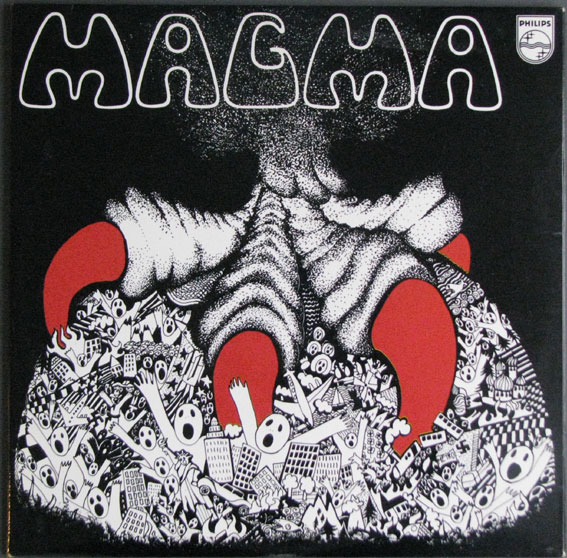 The first album, a 2LP set simply titled Magma, is where the story begins. The first disc concerns itself with the departure and journey to Kobaïa, arrival at their destination, the long and patient process of building a new society according to their vision, and their process of learning how to live in harmony with their new surroundings, while attaining a high degree of technological advancement. The second disc involves the rescue of a foreign spaceship which gets into orbital difficulties over Kobaïa — this ship turns out to be manned by a crew from Earth. The visitors tell of the continued degeneration and disasters that have afflicted Earth, and at the same time are impressed with the progress that the Kobaïans have made, their philosophy and societal organization, and how they have learned to live as one at peace with their surroundings. The Earthmen request that the Kobaïans visit Earth and attempt to propagate their philosophy in order to save society from its certain destruction. After some deliberation, a small party agrees to accompany the stranded visitors on their journey home.
The first album, a 2LP set simply titled Magma, is where the story begins. The first disc concerns itself with the departure and journey to Kobaïa, arrival at their destination, the long and patient process of building a new society according to their vision, and their process of learning how to live in harmony with their new surroundings, while attaining a high degree of technological advancement. The second disc involves the rescue of a foreign spaceship which gets into orbital difficulties over Kobaïa — this ship turns out to be manned by a crew from Earth. The visitors tell of the continued degeneration and disasters that have afflicted Earth, and at the same time are impressed with the progress that the Kobaïans have made, their philosophy and societal organization, and how they have learned to live as one at peace with their surroundings. The Earthmen request that the Kobaïans visit Earth and attempt to propagate their philosophy in order to save society from its certain destruction. After some deliberation, a small party agrees to accompany the stranded visitors on their journey home.
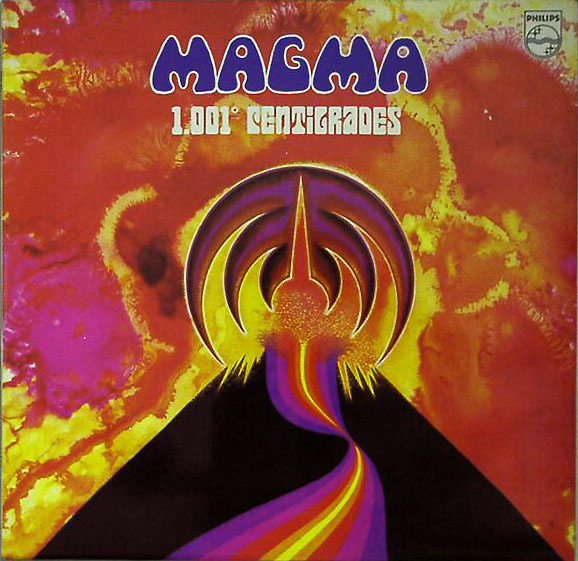 1001° Centigrades, the second Magma album from 1971, begins with the arrival of the Kobaïan party back on Earth, and the seemingly friendly welcome they receive. The Earth people listen to the stories of the establishment and growth of Kobaïan civilization, to their philosophy, and ideas for the betterment of life on Earth through purification and spiritual enlightenment. But after airing these ideas at a meeting with the Earth authorities, the Kobaïan party is promptly imprisoned and their spacecraft is impounded. But a message is sent to Kobaïa, and a rescue effort is begun. The Kobaïan rescue party offers the Earth authorities the choice of releasing the imprisoned Kobaïans, or face certain destruction by the Kobaïans' ultimate weapon. The imprisoned Kobaïans are promptly released, and although they vow never to return, their visit is to be remembered by the few they came in contact with for a long period of time, their ideas preserved and passed on for future generations.
1001° Centigrades, the second Magma album from 1971, begins with the arrival of the Kobaïan party back on Earth, and the seemingly friendly welcome they receive. The Earth people listen to the stories of the establishment and growth of Kobaïan civilization, to their philosophy, and ideas for the betterment of life on Earth through purification and spiritual enlightenment. But after airing these ideas at a meeting with the Earth authorities, the Kobaïan party is promptly imprisoned and their spacecraft is impounded. But a message is sent to Kobaïa, and a rescue effort is begun. The Kobaïan rescue party offers the Earth authorities the choice of releasing the imprisoned Kobaïans, or face certain destruction by the Kobaïans' ultimate weapon. The imprisoned Kobaïans are promptly released, and although they vow never to return, their visit is to be remembered by the few they came in contact with for a long period of time, their ideas preserved and passed on for future generations.
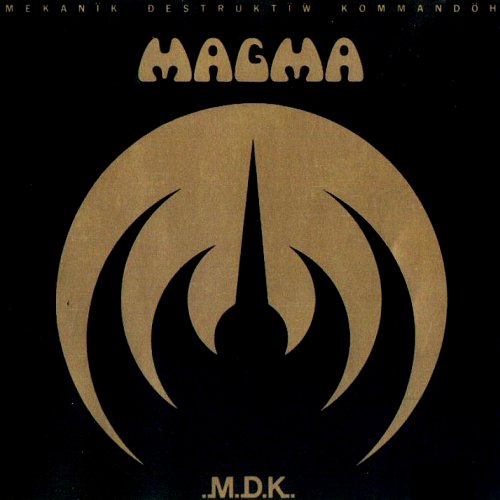 One of these people who remembered the essence of the Kobaïans' visit was a man named Nebehr Gudahtt, a spiritualist who is the subject of the third Magma album, Mekanïk Destruktïw Kommandöh, recorded in 1973. His message to the people of Earth is that their only salvation from an ultimate and certain doom is through self purification and communion with the divine spirit of the supreme being, the Kreuhn Kohrman. With this album we are introduced to the story of the Theusz Hamtaahk (literal translation: Time of Hatred) concerning the period of time on Earth between the Kobaïan visit and the celestial march for enlightenment led by Nebehr Gudahtt which concludes this album. At first Gudahtt's message is rejected, and the people march against him, but as they march they begin to question their very existence and purpose. One by one, they begin to see his truth, slowly reaching enlightenment, and begin to march with him instead of against him.
One of these people who remembered the essence of the Kobaïans' visit was a man named Nebehr Gudahtt, a spiritualist who is the subject of the third Magma album, Mekanïk Destruktïw Kommandöh, recorded in 1973. His message to the people of Earth is that their only salvation from an ultimate and certain doom is through self purification and communion with the divine spirit of the supreme being, the Kreuhn Kohrman. With this album we are introduced to the story of the Theusz Hamtaahk (literal translation: Time of Hatred) concerning the period of time on Earth between the Kobaïan visit and the celestial march for enlightenment led by Nebehr Gudahtt which concludes this album. At first Gudahtt's message is rejected, and the people march against him, but as they march they begin to question their very existence and purpose. One by one, they begin to see his truth, slowly reaching enlightenment, and begin to march with him instead of against him.
MDK is the third movement of the Theusz Hamtaahk, which leads one to the question — where are the first and second movements? Originally, the Theusz Hamtaahk was ambitiously planned to be three cycles of three movements each (nine movements total), but the idea was apparently abandoned after MDK — at least further movements beyond that point were not identified as such. The second movement appeared the following year as the soundtrack to the Yvan Lagrange film Tristan et Yseult, recorded by a scaled down four-piece version of the band and officially listed as a Christian Vander solo record. In fact its CD re-release is credited to Magma and restores its proper title, Wurdah Ïtah (translates to: Dead Earth). The first movement of Theusz Hamtaahk, a full length thirty-five minute opus, was performed regularly live, but was not released on record until the 1980 live album Retrospektïw I-II.
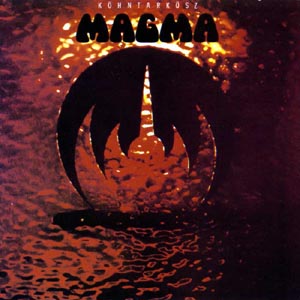 With their fourth album, Köhntarkösz, Magma began what is presumed to be the first movement of the second cycle of the Theusz Hamtaahk, the story of Ëmëhntëhtt-Ré. Here the story gets a bit more cryptic, intentionally so, as by this time Magma's music is taking on a more spiritual and purely musical nature, where vocals seem to be more an element of the music than a vehicle for delivering lyrics. Köhntarkösz is a man who discovers an old Egyptian tomb of an ancient master, murdered before reaching his aim, which was immortality. When he enters the tomb, he has a vision of Ëmëhntëhtt-Ré, and all of his secrets are then revealed to Köhntarkösz.
With their fourth album, Köhntarkösz, Magma began what is presumed to be the first movement of the second cycle of the Theusz Hamtaahk, the story of Ëmëhntëhtt-Ré. Here the story gets a bit more cryptic, intentionally so, as by this time Magma's music is taking on a more spiritual and purely musical nature, where vocals seem to be more an element of the music than a vehicle for delivering lyrics. Köhntarkösz is a man who discovers an old Egyptian tomb of an ancient master, murdered before reaching his aim, which was immortality. When he enters the tomb, he has a vision of Ëmëhntëhtt-Ré, and all of his secrets are then revealed to Köhntarkösz.
The story goes on. A presumed second movement of Ëmëhntëhtt-Ré was never recorded in one piece, but is scattered randomly across the next two albums, Magma Live (the tracks "Hhaï" and "Ëmëhntëhtt-Ré") and Üdü Wüdü (the tracks "Zombies," "Soleil D'Ork," and "De Futura"). At this point the story becomes increasingly unclear. Other tracks like "Om Zanka" and "Gamma Antéria" (from the live album Inedits) and "Ptâh" (from the unauthorized live Mekanïk Zeuhl Wortz) seem to tie into the general concept as well, but Vander has offered few clues as to where the story goes after Köhntarkösz. Magma's 1978 album Attahk appears to have a theme also, but it seems to be unique unto itself and not tied in with any of the previous records. Again, Vander offers few clues. This also marks the last studio album which is sung exclusively in the Kobaïan language.
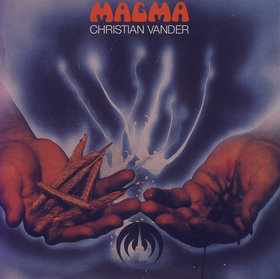 And thus the Kobaïan story closes. Magma's next studio effort, Merci in '84, is sung in French and English, with a couple obligatory tracks in Kobaïan, yet it seems very clear from the music and the overall direction that the band is moving in, that the Theusz Hamtaahk and the whole 70s concept of Magma is something they were trying hard to put behind them. This would also be Magma's final studio release. Within months, Christian Vander's new band Offering was born, moving further and deeper into the more acoustic Coltrane-inspired jazz directions than Magma had ever dared to travel before. One senses the liberation that Offering provided, allowing Vander to explore new avenues that were unsuited to the 70s Magma style. Christian's jazz trio was also born in this period also, plus numerous solo projects, all of which very much deserve to be heard.
And thus the Kobaïan story closes. Magma's next studio effort, Merci in '84, is sung in French and English, with a couple obligatory tracks in Kobaïan, yet it seems very clear from the music and the overall direction that the band is moving in, that the Theusz Hamtaahk and the whole 70s concept of Magma is something they were trying hard to put behind them. This would also be Magma's final studio release. Within months, Christian Vander's new band Offering was born, moving further and deeper into the more acoustic Coltrane-inspired jazz directions than Magma had ever dared to travel before. One senses the liberation that Offering provided, allowing Vander to explore new avenues that were unsuited to the 70s Magma style. Christian's jazz trio was also born in this period also, plus numerous solo projects, all of which very much deserve to be heard.
Clearly, the 70s version of Magma was one of the most influential of all French bands, equaled only by Gong and Ange. They have left a legacy of music that defies any of the standard and convenient classifications of rock, operating instead in a realm of their own creation. It waits to be discovered by new converts, and continually rediscovered by older fans alike. Kobaïa iss de hundin!
Filed under: Profiles, Issue 8
Related artist(s): Magma, Christian Vander / Offering
What's new
These are the most recent changes made to artists, releases, and articles.
- Review: Earthbound - Earthbound
Published 2025-12-28 - Review: Olgoj - A Place to Rest
Published 2025-12-27 - Release: John Weider - John Weider
Updated 2025-12-26 19:13:54 - Artist: John Weider
Updated 2025-12-26 19:09:52 - Release: Moonrider - Moonrider
Updated 2025-12-26 18:51:45 - Artist: Moonrider
Updated 2025-12-26 18:49:51 - Release: Octopus Syng - Insanity Is the Song We Sing
Updated 2025-12-26 12:53:35 - Release: Tre Spiritus - Tre Spiritus
Updated 2025-12-26 12:49:13 - Artist: Tre Spiritus
Updated 2025-12-26 12:48:34 - Release: Arpia - Festa Grande
Updated 2025-12-26 12:42:27 - Release: Sigmund Freud - Risveglio
Updated 2025-12-26 12:37:54 - Artist: Sigmund Freud
Updated 2025-12-26 12:37:08 - Release: Davide Cedolin - Ligurian Pastoral, Vol II
Updated 2025-12-26 00:17:38 - Release: Davide Cedolin - Ligurian Pastoral
Updated 2025-12-26 00:15:05 - Artist: Davide Cedolin
Updated 2025-12-26 00:12:01 - Review: Kokkinià - The Last Are Lost from the List
Published 2025-12-26 - Review: Pymlico - Core
Published 2025-12-25 - Release: Various Artists - Soul of the Machine: A Celebration of the Life & Legacy of ARP Founder Alan R Pearlman
Updated 2025-12-24 15:58:08 - Review: Jussi Reijonen - Sayr: Salt / Thirst & Sayr: Kaiho – Live in Helsinki
Published 2025-12-24 - Review: TOC & Jean-Luc Guionnet - Quelques Idées d'un Vert Incolore Dorment Furieusement
Published 2025-12-24
